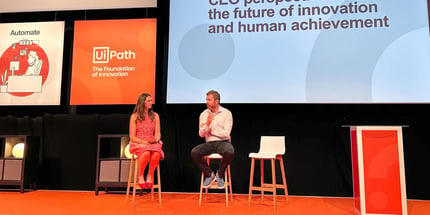About AI
Generative AI
Discover how generative AI and automation work together to enhance efficiency and productivity, transform the customer experience, and drive business transformation.
- What is generative AI?
- Why is generative AI such a transformative technology?
- What is the difference between generative AI and other forms of AI?
- What can GenAI do?
- What are the big GenAI use cases?
- What impact will GenAI have on work and productivity?
- How can GenAI and automation work together in the enterprise?
- How can I use GenAI in my work?
- What are some use cases for GenAI in my business?
- What infrastructure is needed for GenAI?
- How can I find valuable use cases for GenAI?
- What GenAI risks should I be aware of?
- Do I need to hire technical talent to leverage GenAI effectively?
- How can we ensure GenAI is safe and ethical?
- How can I ensure data privacy and security when using GenAI?
- How can I monitor the performance and accuracy of GenAI?
- How can GenAI improve our customer experience?
- How can GenAI improve our operations and efficiency?
What is generative AI?
Generative artificial intelligence (GenAI) is a type of AI that can create new content, such as text, images, audio, and video. GenAI’s large language models (LLMs) are trained through a process called unsupervised learning. In this approach, models are fed huge quantities of data (for example, most of the available content on the internet). Working without explicit instructions or data labeling, generative models using these unsupervised learning techniques can parse through this data and learn to identify and replicate patterns in it.
A number of companies now offer their models commercially on demand, including OpenAI’s ChatGPT, DALL-E, Gemini, Google Bard, and Suno AI, among others. Here’s how generative AI works through these services. When people or other machines enter a prompt through an API—that is, a question to be answered or a request for a certain output—GenAI models draw on the patterns they have discovered to generate responses. Hence, the AI-generated content created by GenAI is based on the data and patterns it has uncovered in the source data.
When the first commercially available foundational model, GPT-3, burst on the scene in late 2022, the global response was unprecedented, with over 100 million people signing up to try it in a matter of weeks. And GenAI models are only continuing to improve and add capabilities as major new entrants come onto the scene.
Why is generative AI such a transformative technology?
Generative AI is a recent type of AI that, for the first time in history, allows machines to create high-quality, human-like content across many areas. GenAI’s AI-powered capabilities now allow computers to play a role in areas that were once solely the domain of humans, such as image generation, music composition, and a wide range of written content, including nonfiction and fiction. Generative AI tools are even helping speed up code generation.
Generative AI also can reason, intuit, and understand data and inputs in ways that rival human capabilities. And it has greatly expanded the capabilities of natural language processing, so now practically any person can communicate with computers in plain, human language—no coding required.
In short, GenAI models typically can complete a wide and growing range of work faster and better than their human counterparts—drawing upon a more complete range of sources and often performing better than humans can. Areas as diverse as drug discovery, copywriting, simulations and scenario planning, medical imaging, and more are discovering the power of generative AI to supplement human analysis and judgment—and sometimes, even surpass it.
But there’s more to the story—and it centers around fueling a major increase in productivity for employees around the globe. Indeed, McKinsey estimates that GenAI “could add the equivalent of $2.6 trillion to $4.4 trillion annually” in global gross domestic product (GDP) just from the 60 or so use cases they analyzed. That’s because GenAI makes it easier and more intuitive for people to partner with machines—so workers can draw on AI’s power to act faster and produce higher-quality work. For example, in an HBS-Sloan-Wharton study, consultants aided by AI could create a marketing plan 25% faster, with 40% higher quality. In software development, PwC estimates that GenAI can boost productivity and speed by 20% to 50%.
Multimodal GenAI systems, capable of understanding both the structured language of data and the unstructured language of everyday speech, bring natural language processing to new heights and, in so doing, have reinvented the human-machine interface. Once, people had to use keyboards and mouse clicks to communicate with a computer. Now, people can get what they need simply by asking for it. Conversational AI has brought the computer-human relationship to an entirely new level.
But GenAI is more than just talk. AI technology is also adept at swiftly processing and understanding an organization's data flows and work processes. AI systems can rapidly and accurately interpret the structure and meaning behind communications, forms, and documents. Armed with this information and contextual data, software robots can take on a big swath of work that once only people could do, giving rise to the booming “copilot” category and rapidly ushering in the age of agentic AI. Virtual assistants are showing up everywhere in enterprise software (Microsoft “Copilots” are but one example.)
All this opens up countless new ways to accelerate productivity and innovation (see “What are the big GenAI use cases?” below). It is small wonder, then, that organizations around the world are seeking to combine LLMs and foundation models (FMs) to build generative AI applications and AI solutions that deliver breakthroughs in customer and employee experiences.
The impact on work will be immense; OpenAI research suggests that almost half of the workforce could eventually have at least 50% of their job tasks performed by AI. Overall, 80% of jobs will feel at least some GenAI impact.
What is the difference between generative AI and other forms of AI?
Broadly speaking, there are two kinds of AI: analytical AI and generative AI. Analytical AI uses techniques like machine learning and neural networks to find patterns in structured and unstructured data and generate structured data. It’s very good at analyzing and processing large volumes of data, transforming structured and unstructured data into the appropriate format for customer relationship management (CRM) tools and databases, predicting behavior and preferences based on a complex set of data, and finding trends and anomalies in large datasets. This is the type of AI that powers things like identifying fraud, predicting weather patterns, making product recommendations, and the like.
Generative AI stands apart from analytical AI because of its unique ability to create. GenAI goes beyond analysis, extraction, and pattern recognition to generate new, original content across various formats like text, images, audio, and video.
GenAI and analytical AI’s differences stem from the different techniques they employ. Analytical AI often relies on supervised learning, where models are trained on labeled data to perform specific tasks. In contrast, GenAI leverages unsupervised learning, absorbing massive amounts of data to discern patterns and relationships without explicit instruction. This allows GenAI to not only understand existing content but also to produce novel outputs that mirror the intricacies of the learned data.
It’s important to remember that GenAI is not inherently superior to analytical AI, or vice versa. Each has its strengths, weaknesses, and roles in the enterprise. Analytical AI systems tend to be more accurate and performant for the specific tasks for which they were developed, whereas GenAI excels at more creative, generative tasks that analytical AI can’t replicate.
But these two AI categories often overlap. UiPath CommPath and UiPath DocPath are two specialized GenAI models that use both supervised and unsupervised learning to process any document and a wide variety of communication types.
What can GenAI do?
GenAI has a wide and transformative range of capabilities that set it apart from traditional AI. It excels at crafting original, high-quality content across various formats, including text, images, audio, and even nascent video.
Beyond content creation, GenAI can reason and problem-solve, comprehend and translate languages, and even collaborate creatively with humans and with other GenAI models.
What are the big GenAI use cases?
GenAI is reshaping how tasks are approached and unlocking new possibilities across a variety of sectors.
Banking and financial services
In banking and financial services, GenAI is streamlining customer service through intelligent chatbots that can handle inquiries and resolve issues in real time. It's also stepping up fraud detection by identifying patterns and anomalies in massive amounts of financial data. And it's empowering personalized financial advice platforms that offer tailored recommendations to individual investors.
Insurance
The insurance industry is experiencing a GenAI revolution. Claims processing is being streamlined through automation, saving valuable time and resources. Risk assessment is also being enhanced, with GenAI analyzing massive datasets to pinpoint potential risks and ensure accurate policy pricing. But that's not all—GenAI is also opening doors to personalized insurance offerings, tailoring policies to meet the unique needs of each customer.
Public sector
GenAI is becoming a key player in the public sector. It's transforming citizen services with intelligent chatbots that can answer questions and provide information 24/7. It's also making communities safer by analyzing data to predict crime patterns, and it's even helping government agencies streamline operations through automation.
Manufacturing
In the manufacturing sector, GenAI is spearheading the next wave of innovation. It's revolutionizing production by analyzing data from sensors and machines, pinpointing inefficiencies and predicting maintenance needs before they become costly problems. GenAI is also a quality control champion, spotting defects and anomalies in products with ease. It's even empowering mass customization, allowing manufacturers to create products that cater to each customer's unique desires.
Telecommunications
The telecommunications industry is embracing GenAI to turbocharge network performance and enhance customer experiences. GenAI is optimizing network traffic by analyzing data to identify bottlenecks and predict congestion, ensuring smoother connections for everyone. It's also personalizing customer service through chatbots that can address questions and concerns in real time.
Customer experience
GenAI is redefining the customer experience across all industries. It's fueling intelligent chatbots that offer 24/7 support and resolve issues quickly and efficiently. It's also delivering personalized recommendations and product suggestions, creating a shopping experience tailored to each individual's preferences. And GenAI is even boosting customer engagement through interactive content and immersive virtual experiences.
Healthcare
GenAI holds the potential to significantly transform many aspects of healthcare, from diagnosing diseases to capturing and interpreting patient notes to recommending treatments and beyond. It has the ability to capture and synthesize a wide range of disparate data in many forms—freeing caregivers to focus less on wrangling and interpreting data, and more on working with patients. And that’s just on the clinical side of healthcare. GenAI is also being used for drug discovery, hospital billing and revenue leakage, insurance claims management, and more.
Other industries
The potential of GenAI goes beyond these use cases. As the technology continues to evolve, the possibilities for innovation are endless.
What impact will GenAI have on work and productivity? Where will it have the most impact?
GenAI is unlocking a productivity surge across the workplace, revolutionizing how we work and the very nature of work itself. By streamlining routine tasks and empowering employees with intelligent tools, GenAI will free up human workers to focus on higher-level creative and strategic endeavors.
Industries that rely heavily on information processing and pattern recognition are expected to feel the biggest impact. Think finance, where GenAI can rapidly analyze massive datasets to unearth hidden trends and build predictive models, or insurance, where it can streamline risk assessment and claims processing.
Customer service and sales roles are also ripe for transformation, with AI-powered chatbots providing round-the-clock, personalized customer support and virtual assistants supercharging sales interactions.
The list goes on. GenAI is turbocharging creativity in marketing, design, and content creation. It can draft marketing copy, design layouts, and even generate scripts, enabling creative professionals to focus on refining and elevating ideas instead of starting from scratch.
How can GenAI and automation work together in the enterprise?
GenAI and automation are perfect partners, each one reinforcing and amplifying the strengths of the other. GenAI and automation represent the ‘brain power’ and ‘motive power’, respectively. That is, GenAI provides the advanced reasoning and automation provides the integrations and ability to move GenAI output into workflows and decision streams throughout the enterprise.
In addition, GenAI has greatly expanded what can be automated and what automation platforms can do, propelling them beyond simple rules-based tasks and into the realm of human activity. For example, GenAI now makes it possible to automate workflows where content needs to be created, such as replying to a customer email or powering a chatbot.
GenAI is also accelerating the development and deployment of automation solutions. With its ability to generate code and scripts, it's streamlining the creation of automation workflows. This not only reduces the time and cost associated with automation but also opens up the possibility of automation for smaller businesses and non-technical users.
But GenAI-automation benefits flow both ways. For example, automation has great power to improve the reliability of GenAI’s output, because it can feed models with valuable contextual data gleaned from an enterprise’s internal systems and data repositories.
With its myriad connectors and integrations, automation also gives GenAI the ability to action business data across the organization. That might be to personalize customer interactions en masse or get concise summaries of complex Know Your Customer (KYC) data to deliver faster decisions. Automation allows GenAI to collect all the relevant context it needs, then gives it the power to act on that data at scale.
The convergence of GenAI and automation is giving rise to a new generation of intelligent automation platforms that can learn and adapt, making them more versatile and effective. These platforms can analyze data, extract insights, and even generate recommendations, all without human intervention. This is leading to a paradigm shift in automation, where machines are not just following instructions but actively contributing to problem-solving and decision making.
How can I use GenAI in my work?
GenAI is revolutionizing the way we work, offering a plethora of opportunities to enhance productivity, creativity, and innovation in almost any field.
Boost your productivity
GenAI can streamline tedious tasks like drafting emails, summarizing reports, and even generating code snippets, freeing up your time to focus on higher-level thinking and strategic planning. It can also act as a virtual assistant, scheduling meetings, managing your inbox, and even brainstorming ideas with you.
Unleash your creativity
GenAI can be your creative copilot, generating marketing copy, designing visuals, and even composing music. It can spark new ideas, offer alternative perspectives, and help you overcome creative blocks. Whether you're a manager, executive, or even a college student, GenAI can augment your creativity and help you produce work that stands out.
Gain deeper insights
GenAI can analyze vast amounts of data to uncover hidden patterns, trends, and insights that would be impossible for humans to detect. This can be invaluable for market research, customer analysis, and even product development.
Streamline your workflows
GenAI can streamline complex processes, from customer support to data analysis, saving you time and resources. It can also help you collaborate more effectively with your team by facilitating communication, knowledge sharing, and project management.
The key is to embrace GenAI as a powerful tool that can augment your capabilities, not replace them.
What are some use cases for GenAI in my business?
- Customer service chatbots
- Content generation
- Data analysis and insights
Customer service chatbots
Let GenAI handle the front lines of customer support. AI-powered chatbots can field inquiries, provide personalized assistance, and even troubleshoot common issues. This frees up your human agents to focus on complex cases and deliver top-notch service where it counts.

Content generation
Struggling to keep up with content demands? GenAI can lend a hand. From crafting compelling marketing copy and product descriptions to generating engaging social media posts, GenAI ensures a consistent brand voice and saves your team valuable time.

Data analysis and insights
Uncover hidden gems within your data. GenAI sifts through mountains of information to reveal patterns, trends, and insights that can guide your business decisions, predict customer behavior, and fuel innovation. However, for the most accurate insights and reliable analysis, enterprises should use specialized AI models trained on their own business data.

What infrastructure is needed for GenAI?
A robust infrastructure is required to harness the full potential of GenAI. This includes high-performance computing resources, such as powerful processors and ample memory, to handle the intensive computational demands of training and running GenAI models. Additionally, large amounts of storage are needed to store the vast datasets used to train these models.
Networking infrastructure plays a crucial role in enabling efficient communication between different components of the GenAI system, while specialized software tools are essential for developing, training, and deploying GenAI models. These tools often include libraries, frameworks, and platforms that simplify the complex process of working with GenAI.
Furthermore, as GenAI models continue to grow in size and complexity, the need for specialized hardware like graphics processing units (GPUs) and tensor processing units (TPUs) becomes increasingly important. These specialized processors are designed to accelerate the calculations involved in training and running GenAI models, making the entire process faster and more efficient.
In this context, cloud infrastructure has immense value. It offers scalability to match the demanding computational needs of generative AI, state-of-the-art processors, and large storage capacities. On top of that, the cloud provides advanced security measures, which are crucial for protecting sensitive GenAI models.
Security is another critical consideration in GenAI infrastructure. As these models become more powerful and capable of generating sensitive information, protecting them from unauthorized access and misuse becomes paramount. This involves implementing robust security measures, such as encryption, access controls, and regular security audits.
How can I find valuable use cases for GenAI?
To uncover valuable use cases for GenAI within your business, look for tasks that involve:
Repetitive or mundane work: GenAI can help to streamline these tasks, freeing up your employees to focus on more strategic and creative work.
Large amounts of data: GenAI excels at analyzing and extracting insights from vast datasets, helping you make more informed decisions.
Content creation: whether it's drafting emails, generating marketing copy, or creating social media posts, GenAI can help you produce high-quality content quickly and easily.
Personalization: when sufficiently grounded in your business data and context, GenAI can tailor experiences to individual customers, boosting engagement and satisfaction.
Don't be afraid to experiment and think outside the box. GenAI is a versatile tool with a wide range of potential applications. By exploring different use cases, you can discover innovative ways to leverage GenAI to drive efficiency, innovation, and growth in your business.
What GenAI risks should I be aware of?
While GenAI offers a wealth of opportunities, it's important to be aware of the potential risks:
Inaccuracy and misinformation
GenAI models can sometimes produce inaccurate or misleading information, especially when trained on biased or incomplete data. It's crucial to verify the information generated by GenAI before relying on it.
Bias and discrimination
These models can inadvertently perpetuate biases present in the data they are trained on. This can lead to discriminatory outcomes, especially in sensitive areas like hiring and lending. It's essential to be aware of these biases and take steps to mitigate them.
Intellectual property and copyright concerns
As GenAI can generate new content, questions of ownership and copyright can arise. It's important to understand the legal implications and ensure that you're not infringing on anyone's intellectual property rights.
Privacy and security risks
GenAI models often process sensitive data, making them potential targets for cyberattacks. It's crucial to have robust security measures in place to protect this data from unauthorized access and misuse.
Do I need to hire technical talent to leverage GenAI effectively?
While having in-house technical expertise can certainly be beneficial, it's not always necessary to fully leverage GenAI. Many platforms and tools are designed with user-friendliness in mind, requiring little to no coding knowledge.
Additionally, numerous consulting services and implementation partners specialize in helping businesses integrate and employ GenAI effectively. (For example, the UiPath Business Automation Platform™ provides easy, no-code access to its first-party generative AI models, UiPath DocPath and UiPath CommPath, and provides GenAI governance, monitoring, and orchestration through the UiPath AI Trust Layer.)
Leveraging third-party tools and “built-in” GenAI can help you identify the right GenAI solutions for your specific needs, ensure a smooth implementation process, and maximize the return on your investment. So, a deep bench of internal talent isn’t a hard-and-fast prerequisite for harnessing the power of GenAI.
How can we ensure GenAI is safe and ethical?
Ensuring the safe and ethical use of GenAI involves a multifaceted approach that addresses several key areas:
Data transparency and bias mitigation
Carefully curate and evaluate training data to minimize biases and ensure fairness in GenAI outputs. Be transparent about the data used and potential limitations of the models.
Robust security measures
Implement stringent security protocols to protect sensitive data used by GenAI systems, safeguarding against unauthorized access and potential misuse.
Human oversight and accountability
Maintain human oversight of GenAI applications to monitor for potential issues and make informed decisions. Clearly define responsibility and accountability for the outcomes of GenAI systems. Embed human in the loop processes in every generative AI workflow to ensure outputs are safe, accurate, and responsible.
Continuous monitoring and improvement
Regularly evaluate the performance of GenAI models, identifying and addressing any biases or unintended consequences. Continuously refine and improve models based on feedback and real-world usage.
Transparency and explainability
Strive for transparency in how GenAI models are developed and deployed. Provide explanations for the reasoning behind GenAI-generated outputs to ensure accountability and build trust.
Ethical guidelines and regulations
Establish clear ethical guidelines for the development and use of GenAI. Adhere to relevant regulations and industry standards to ensure responsible and ethical practices.
How can I ensure data privacy and security when using GenAI?
Ensuring data privacy and security when using GenAI requires a multi-pronged approach. Start by carefully selecting a reputable GenAI provider with a strong track record in data protection. Review their privacy policies to understand how your data is collected, stored, and used.
Prioritize GenAI platforms that offer robust security features like encryption, access controls, and regular audits. Consider using anonymization techniques to remove personally identifiable information (PII) from data before feeding it into GenAI models. Be cautious about sharing sensitive data with GenAI models and limit the amount of data you input to only what's necessary.
Regularly monitor the output of GenAI models to identify any potential privacy breaches or unintended consequences. Implement mechanisms to track and audit the use of GenAI to ensure compliance with privacy regulations.
Educate your employees on the importance of data privacy and the responsible use of GenAI. Establish clear guidelines for handling sensitive data and using GenAI tools. By taking these proactive measures, you can mitigate risks and ensure that GenAI is used responsibly and ethically within your organization.
How can I monitor the performance and accuracy of GenAI?
Monitoring GenAI performance and accuracy is an ongoing process that combines technical and human oversight.
On the technical side, you can establish benchmarks for your GenAI model's output, measuring it against specific criteria like accuracy, relevance, and consistency. Using automated tools that can analyze and evaluate GenAI responses against these benchmarks can be incredibly helpful.
But don't discount the importance of human judgment. Regularly review samples of your GenAI model's output to ensure it aligns with your expectations and standards. This can involve manually checking for accuracy, identifying potential biases, and assessing the overall quality of the generated content. Feedback loops are crucial, so create a system for gathering and analyzing user feedback on GenAI-generated content. This can help you pinpoint areas for improvement and fine-tune your model over time.
The accuracy and performance of GenAI models can vary depending on the complexity of the task, the quality of the training data, and the specific model used. By employing a combination of technical tools and human evaluation, you can ensure that your GenAI applications are consistently delivering high-quality results that meet your business objectives.
How can GenAI improve our customer experience?
GenAI is a game-changer when it comes to taking customer experience to the next level. How? By offering instant, round-the-clock support through intelligent chatbots that can tackle common issues, freeing up your human agents to focus on more complex cases.
But that's not all. GenAI goes the extra mile by personalizing recommendations and offers based on each customer's unique preferences and history. On top of that, GenAI can sift through tons of customer feedback to understand what's hitting the mark and where you can improve, helping you stay ahead of the curve.
In short, GenAI is your secret weapon for creating a customer experience that's responsive, personalized, and engaging—the kind that leaves a lasting impression and keeps customers loyal.
How can GenAI improve our operations and efficiency?
GenAI can also take operational efficiency up a notch. It can analyze vast amounts of operational data to pinpoint bottlenecks, predict potential issues before they arise, and even suggest optimization strategies. This could mean anything from streamlining your supply chain to improving resource allocation.
GenAI can also play a crucial role in quality control, identifying defects and anomalies in your products or services before they reach customers.





